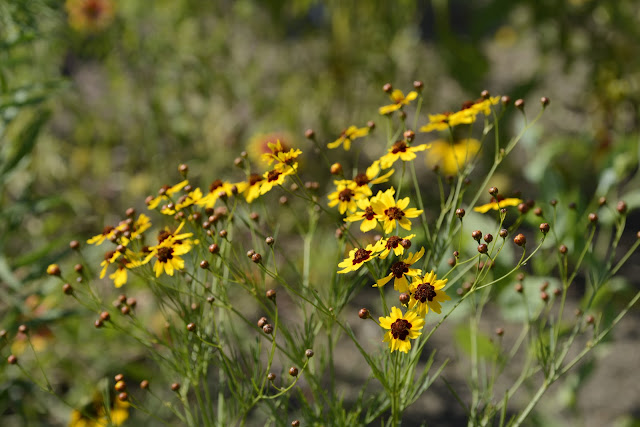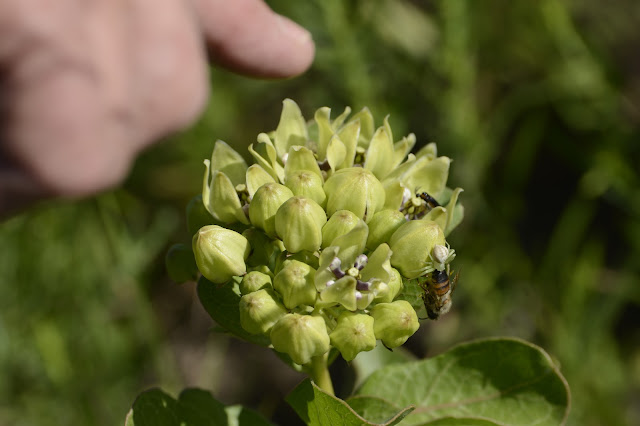After meeting at the pavilion, we (four cars of ten people total) caravaned behind Dr. Steigman eastward through the normally locked gate at the dam outflow to some of the far eastern parts of the preserve. This area is often referred to as the "bison prairie", since it is where LLELA used to maintain a bison herd.
As explained by Dr. Steigman, this area was a "borrow pit" or area where dirt was "borrowed" by the Army Corps of Engineers last year to repair the dam.
As part of the reclamation of the area, it was reseeded last fall. It is mostly the annual wildflowers that have taken hold so far. The ground cover is not very thick yet, since the warm weather grasses and perennials have yet to take off, but that made the meander through the prairie easier than it might have been otherwise. However, that in no way detracted from the stunning array of color.
The predominant flowers were lemon beebalm and Indian blanket, with a fair amount of clasping coneflowers thrown in.
 |
| Indian blanket, lemon beebalm, and clasping coneflowers |
When crushed, the leaves of the lemon beebalm smell very minty, the reason the plant is also called purple horsemint.
 |
| Indian blanket |
 |
| Lemon beebalm and clasping coneflowers |
I thought I knew what a thistle was. Mostly I do. However, there are many kinds of thistles and all thistles have prickly leaves.
 |
| Thistle |
A flower that looks similar to a thistle is the basket flower. The flower is similar looking, but the bud looks like a woven basket. Although the bud looks like it might be prickly, it is not. This plant is not a thistle.
 |
| Basket flower, NOT a thistle |
 |
| Bud of the basket flower that looks like a basket, hence the name. |
There were lots of other flowers sprinkled in.
 |
| Some type of coreopsis -- note the round flower buds |
One plant with a very showy pink blossom had mimosa-like leaves that curled up when touched, a so-called "sensitive plant".
 |
| A type of sensitive plant, possibly Roemer's sensitive brier. |
There were also butterflies and other critters, although not as many as I would have imagined given the number of flowers.
 |
| Checkered white butterfly on an Indian blanket. Note the butterfly's long proboscis |
 |
| Eastern tailed blue butterfly (so-named due to the tiny tails at the bottom of the wings) on a yet unidentified flower that I think may be diamond-flowers. |
Although the flowers were beautiful, there was a lot of drama going on at the micro level. We saw many lady bugs chowing down on aphids.
We saw a crab spider that had captured a honey bee on a milkweed plant. Unlike many spiders, that build webs to trap their prey, this spider is camouflaged and attacks when the prey lands nearby. I was amazed that the spider could take on something so much larger than he was.
 |
| Honey bee captured by a crab spider on a milkweed plant. |
Perhaps appropriate for Mother's Day weekend, we also saw a very brave mother killdeer who held her ground on her nest. We nearly stepped on her since she was along the side of the road in the gravel. I did not see them, but some others in the group saw her eggs. It is apparently common for killdeer to lay their eggs among the gravel since that makes them somewhat camouflaged. Dr. Steigman indicated he occasionally sees them with their eggs in the middle of the gravel road rather than at the side...bird brains!
 |
| Killdeer along the side of the road |
I have not done justice to the large number of different flowers we saw. I won't try to document everything. I don't remember the names of everything anyway. I have posted many of our observations...at least the ones that we got pictures of...on iNaturalist.org. (Click here to see our iNaturalist observations. Those on May 13 were all from this trip.)
In any case, with the great show of flowers and the perfect cool weather it was a great trip.
Wait, what is that person on the road below the dam doing?
 |
| Photographer for the group pic |
Had to take the group pic!
 |
| Wild Flower Walk participants, courtesy of Larry Brennan. |
 |
| Dueling Telephotos, with permission of Larry Brennan. |


